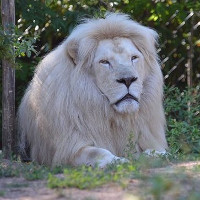 |
White lion |
|
He is a wild animal |
Origin |
South Africa | |
Translation |
Francis Vandersteen |
| The possession of this animal is not authorized Royal Decree establishing the list of mammals not kept for production purposes that may be kept (M.B. 24.08.2009) |
| The white lion is a mutant form of the lion subspecies Panthera leo krugeri; it is not a separate subspecies. It is occasionally encountered in South African nature reserves, and is selectively bred in zoos around the world. The allele responsible for the mutation is recessive, so white lions remain rare in the wild, and only a pair of white lions can produce white cubs with any certainty; white cubs are occasionally born to normal lions in Timbavati and Kruger National Park. The largest population of white lions is found in zoos, where they are bred to perpetuate their color, with the attendant risk of inbreeding. White lions do not suffer from albinism, but from leucistism. Pigments are visible in their eyes (which can never be red, but golden/hazel like those of normal lions, but can also be blue-gray or green - it is possible to selectively breed blue-eyed lions), on their pads and lips. Their leucistism is due to the chinchilla mutant allele, which inhibits the deposition of pigment except on the tips of the hairs. As a result, the color of white lions ranges from blond to almost pure white. Males' manes and caudal "brushes" are blond or cream instead of black. White lions have never been common in the wild, and at present the largest population is kept in zoos around the world, where they are bred for biological conservation and biodiversity. However, inbreeding problems soon became apparent. During the years 2003 to 2008 in a zoo in northern Italy, 19 white lions were born to the same parents, who were in turn paternally inbred. Of the 19 lions, 4 were stillborn, 13 died within a month of birth, and one was euthanized after six months. As with the white tiger, Species Survival Plan (SSP) coordinators strongly discourage the crossing of lions for the sole purpose of creating white lions. Today, the most unfortunate thing to say is that some unscrupulous zoos promote the status of the white lion, as they did with the white tiger, in order to attract visitors. On the other hand, given the rarity of the white lion, it's totally unbelievable that circuses can strut around presenting these felines as attractions. Today, five reputable circuses have white lions in their possession. The animal already has no place in a circus, so what can we say about the presence of these magnificent felines in circus tents to entertain the crowds? |






 English (United Kingdom)
English (United Kingdom)